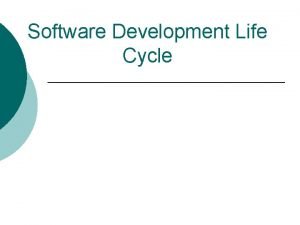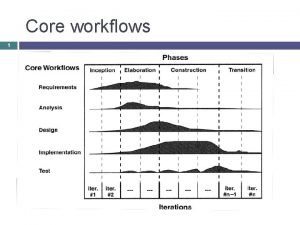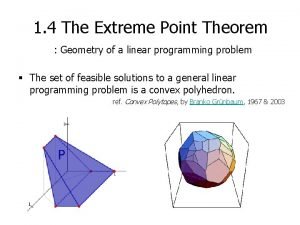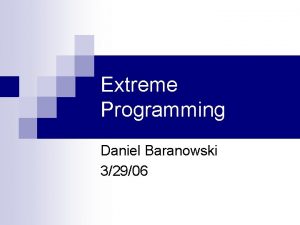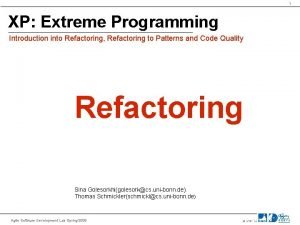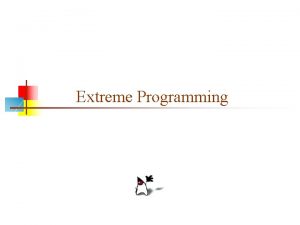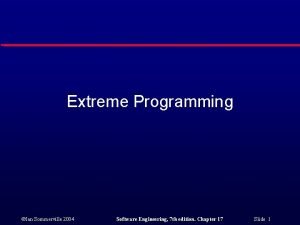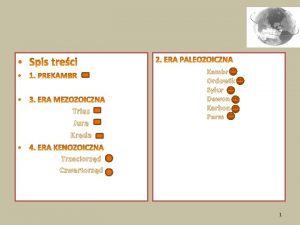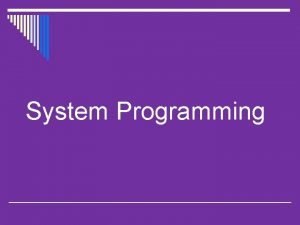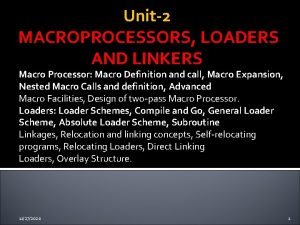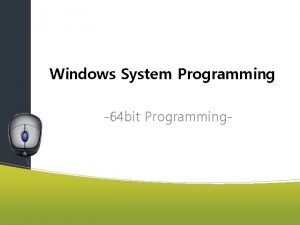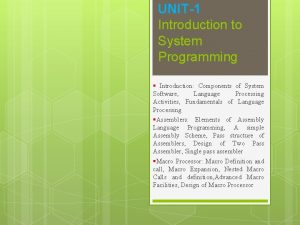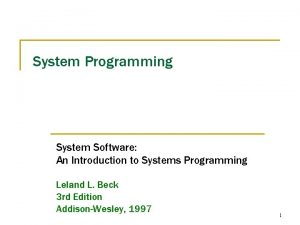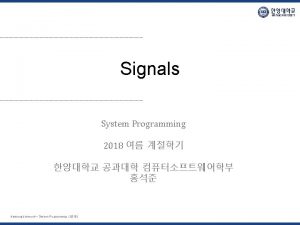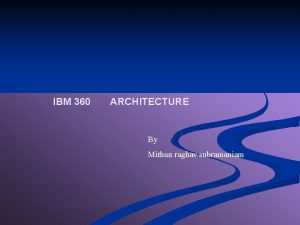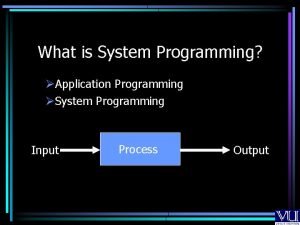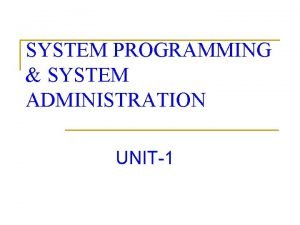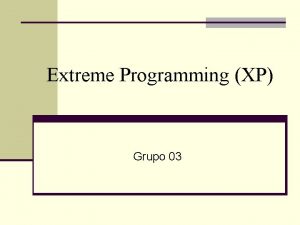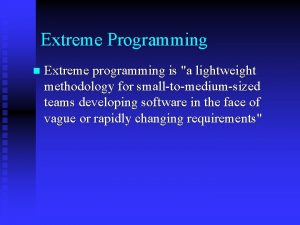my Agile Extreme Programming plus Grade System Agile




































![SORT Algorithm for i from 0 upto N-2 1. min(最小數的索引)指著array[i. . N-1]的第一個位置 (即array[i]) 2. SORT Algorithm for i from 0 upto N-2 1. min(最小數的索引)指著array[i. . N-1]的第一個位置 (即array[i]) 2.](https://slidetodoc.com/presentation_image/80053969aad8ab20307c0a2fa21fcd24/image-37.jpg)



![Pseudo code 結構 1. Sequence 如: 1. 從 array[i. . N-1] 中select出 min,且換到它的第一個位置 2. Pseudo code 結構 1. Sequence 如: 1. 從 array[i. . N-1] 中select出 min,且換到它的第一個位置 2.](https://slidetodoc.com/presentation_image/80053969aad8ab20307c0a2fa21fcd24/image-41.jpg)










- Slides: 51



做法 一個方法 my. Agile (Extreme Programming plus) 一個專案 Grade System (成績系統) 一個網站 Agile Taiwan (台灣敏捷方法苗圃) 今天先淺談敏捷觀念後 談 1) my. Agile方法 2) Grade System Project 3

美國先進軟體公司 佈置圖 common white board caves 4





Communication Cycle 溝通週期 不斷溝通、回饋、檢查、除錯、修改; 幫助人人成長、技術精進 回合規劃 簡約設計 站著 開日會 交貨規劃 Pair Programming with On-site Customer 1. . N Bugs CYCLE TIME 5 seconds 重構 CYCLE TIME 1 day 1. . N Iterations CYCLE TIME 3 weeks 1. . N Increments CYCLE TIME 2 months 測試碼保護中 1. . N Methods CYCLE TIME 0. 5 day 持續整合 增量 增量加 上次交貨 9


1)my. Agile 方法 11

my. Agile 敏捷方法 (11道 序) + * * 0. 探索需求 (Exploring requirements) 1. 使用情節 (Scenario) 2. 驗收測試案例及使用手冊 (Acceptance test case & User Manual) n 3. 架構設計會議 (CRC session) n 4. 派 及時程 (Dispatching and Scheduling) n 5. 單元測試碼 (Unit test code) + 6. 資料結構設計 (Data Structure Design) + 7. 演算法設計 (Algorithm Design) 含設計草圖及虛擬碼 n 8. 補上程式碼 (Coding) n 9. 單元及驗收測試 (Unit & Acceptance testing) + 10. 逆向 程 具 (Reverse Engineering Tool) (+是補充 序, *是加強 序 , 其餘即 Extreme Programming) 12



my. Agile 重點 Big requirement up front my. Agile 由簡而繁寫多個cases 比傳統軟 只寫一個case 更為加強 Rough architecture design up front my. Agile 採用 XP 的 CRC 快速做架構設計 又用 reverse eng. tool 自動獲得設計圖 免畫圖. Big detailed design my. Agile 採用 design sketch, pseudo-code 相當細緻 15

3. 架構設計會議 (CRC Session) CRC(Class, Responsibility, Collaborator)會議: 五人以內圍坐,執行驗收測試案例,推敲切割 (partition)之, 找出物件(object)及物件互動(object interaction,即method),須含下層隱藏物件(hidden objects), 用小卡片(CRC card, 可用A 4紙)記錄: 1. Class name (C), 2. 要做何事 Responsibility (R), (將轉為 method) 3. 要誰合作(即需呼叫誰的 responsibility) 叫 Collaborator (C) 會議後所有 CRC cards 即系統架構(class interfaces), 此會議是群體智慧- 腦力激盪,快速溝通 16




Class Interface 例子 my. Sort 的class interface: public class my. Sort { /*稍後 data structure 在此 */ public my. Sort (int input. Array[]){ } public int [] sort () {} } // end of my. Sort method interface 20


Header(標頭) 兩例 /* method sub. String -----------------------* A String object呼叫此 method,傳回介於兩個 indexes 之間的子字串 * * @param begin. Index 子字串起始的 index (含此 index) * @param end. Index 子字串最後的 index (不含此 index) * @return 由 begin. Index 到 “end. Index 的前一個位置” 的子字串 * * @throws Index. Out. Of. Bounds. Exception – * if begin. Index 是負數 or * begin. Index 大於 end. Index or * end. Index 大於 length() * * Time estimate : 演算法設計後,才獲此資訊,如 O (n) * Example: “helloworld”. sub. String(3, 6) ; 傳回結果為 “low” -------------------------------------*/ public String sub. String (int begin. Index, int end. Index) 22

/* class Event. Detection. Thread -----------------* * 本 thread 產生 detector, 它start後, 每 0. 5秒(500 ms)到預設的. /buffer資料夾抓取(fetch)一個event (. xml)的path * 並通知 observer (叫 event parser) 此path. * 如資料夾是空的, 則回傳null. * * Example: *. /buffer資料夾有存進來的三個events: * *091123153040000. xml (最早存進來) *091123153040500. xml * year 09 month 11 day 23 time 1530 ms 40500 *091123153041000. xml (最晚存進來) * * detector 依序抓取之 *------------------*/

序一至三片段例子 序是前後聯貫的 例如: 1. Scenario: show finish message (msg) 2. Acceptance test case: show finish message (msg) “結束了” 3. Architecture design: /*---------------show finish message “結束了” ----------------*/ public void show. Finish. Msg() 24






Test Code Example //Test Case 1:input {3, 1, 4, 2} expected output:{1, 2, 3, 4} public void test. Sort 1() { /* input為待排序數列,expected為預期結果, actual為實際結果*/ int input[] = {3, 1, 4, 2}, expected[] = {1, 2, 3, 4}; int actual[]; /* new 一個 my. Sort的物件,傳入參數input */ my. Sort obj = new my. Sort(input); /*呼叫sort來排序 其實際結果存入actual*/ actual = obj. sort(); /* assert實際結果與預期結果是否 equal */ assert. Equals (to. String(actual), to. String(expected)); } 30

Test Cases As Test Code Header //Test Case 1: input {3, 1, 4, 2} expected output:{1, 2, 3, 4} //Test Case 2: input {1, 1, 1, 1} expected output:{1, 1, 1, 1} //Test Case 3: input {3, 2, 4, 2} expected output:{2, 2, 3, 4} public void test. Sort 1() { /* input為待排序數列,expected為預期結果, actual為實際結果*/ int input[] = {3, 1, 4, 2}, expected[] = {1, 2, 3, 4}; int actual[]; ……. . public void test. Sort 2() { …… public void test. Sort 3() { ……… 31

6. 資料結構設計 (Data Structure Design) n 對每個 class,要設計這 class 所含的 public methods 共同要用的 data 的 structure n 儘可能設計出 high-level data structure 如tree 而非 low-level data structure 如array 這樣可簡化 method 演算法設計 32




![SORT Algorithm for i from 0 upto N2 1 min最小數的索引指著arrayi N1的第一個位置 即arrayi 2 SORT Algorithm for i from 0 upto N-2 1. min(最小數的索引)指著array[i. . N-1]的第一個位置 (即array[i]) 2.](https://slidetodoc.com/presentation_image/80053969aad8ab20307c0a2fa21fcd24/image-37.jpg)
SORT Algorithm for i from 0 upto N-2 1. min(最小數的索引)指著array[i. . N-1]的第一個位置 (即array[i]) 2. 從 array[i. . N-1] 中select出 min for j from i+1 upto N-1 if 第 j 個數比 min 所指的數小then 叫它min end if end for 3. 把 min 所指的數換到 array[i. . N-1]的第一個位置 end for 37



英詞 命名 Class, object, variable 以名詞命名 class 用大寫開頭 最好複數 (如Desks) object 用單數 最好有冠詞 (如my. Desk) 只有一個 object,不致混淆,則省冠詞 如 symbol. Table 而非 a. Symbol. Table Method 以動詞命名,並以參數區別之,如: buy (Desks my. Desk) buy (Tables his. Table) 為不同 methods 40
![Pseudo code 結構 1 Sequence 如 1 從 arrayi N1 中select出 min且換到它的第一個位置 2 Pseudo code 結構 1. Sequence 如: 1. 從 array[i. . N-1] 中select出 min,且換到它的第一個位置 2.](https://slidetodoc.com/presentation_image/80053969aad8ab20307c0a2fa21fcd24/image-41.jpg)
Pseudo code 結構 1. Sequence 如: 1. 從 array[i. . N-1] 中select出 min,且換到它的第一個位置 2. 固定此數不再更動 只有1. 無 2. 時,不構成sequence,故不寫 1. 2. Selection 如: if 第 j 個數比 min 所指的數小 then 叫它min else null end if 又如 case. . end case 3. Iteration 如: for j from i+1 upto N-1 if 第 j 個數比 min 所指的數小 then叫它min end if end for 又如 while. . end while loop … end loop 41



演算法設計例子(Cont. ) /*----------------------------* show. Names 顯示 house. List 各人名 * * @param house. List 例 小華 阿偉 * Time estimate: O(n) ----------------------------*/ private void show. Names (House. List house. List) loop 顯示 house. List 各元素所含的人名 end loop 44


補上程式碼 例子 /*----------------------------* show. Names 顯示 house. List 各人名 * * @param house. List 例 小華 阿偉 * Time estimate: O(n) ----------------------------*/ private void show. Names (House. List house. List) /*loop 顯示 house. List 各元素所含的人名 end loop*/ for(i=0, i<=length(house. List-1), i++) println (house. List(i). name); 注意: 要凸顯虛擬碼 隱藏程式碼 以利閱讀 46




Class diagrams generated by tool 50

(2) Grade System Project 51
 Dsdm
Dsdm Extreme wide shot (news)
Extreme wide shot (news) Definition of system programming
Definition of system programming Advantages of extreme programming
Advantages of extreme programming Extreme programming history
Extreme programming history Extreme programming in software engineering
Extreme programming in software engineering Extreme programming xp ventajas y desventajas
Extreme programming xp ventajas y desventajas Slidetodoc.com
Slidetodoc.com Extreme programming diagram
Extreme programming diagram Extreme programming workflow
Extreme programming workflow Extreme point theorem linear programming
Extreme point theorem linear programming Daniel baranowski
Daniel baranowski Extreme programming
Extreme programming Dilbert extreme programming
Dilbert extreme programming Refactoring extreme programming
Refactoring extreme programming Extreme programming ventajas y desventajas
Extreme programming ventajas y desventajas Extreme programming
Extreme programming User requirements are expressed as in extreme programming
User requirements are expressed as in extreme programming Perbedaan linear programming dan integer programming
Perbedaan linear programming dan integer programming Greedy programming vs dynamic programming
Greedy programming vs dynamic programming Integer programming vs linear programming
Integer programming vs linear programming Definisi linear
Definisi linear Jerusalem cite de dieu chant
Jerusalem cite de dieu chant Je contiens du sucre sans être sucré qui suis-je
Je contiens du sucre sans être sucré qui suis-je Kambr ordowik
Kambr ordowik Plus j'apprends plus je me rends compte de mon ignorance
Plus j'apprends plus je me rends compte de mon ignorance Agile product lifecycle management software
Agile product lifecycle management software Agile pdm system
Agile pdm system Descriptors grading scale and remarks
Descriptors grading scale and remarks Cinderella rhyme for jump rope
Cinderella rhyme for jump rope Culinary
Culinary Grades of milk
Grades of milk Grade grade
Grade grade Metamorphic grade
Metamorphic grade Declarative statement in assembly language
Declarative statement in assembly language Analysis phase of assembler
Analysis phase of assembler Disadvantages of general loader scheme
Disadvantages of general loader scheme Pass 1 assembler
Pass 1 assembler Programming raster display system in computer graphics
Programming raster display system in computer graphics Ascii table windows
Ascii table windows Comp 40
Comp 40 Windows system programming
Windows system programming Write the format of mot in system programming
Write the format of mot in system programming Language processor
Language processor Sic programming examples
Sic programming examples System programming
System programming Ibm 360 architecture
Ibm 360 architecture System programming
System programming System application programming
System application programming Semantic gap in system programming
Semantic gap in system programming Screen editor in system programming
Screen editor in system programming Plan plus decentralized planning system
Plan plus decentralized planning system







